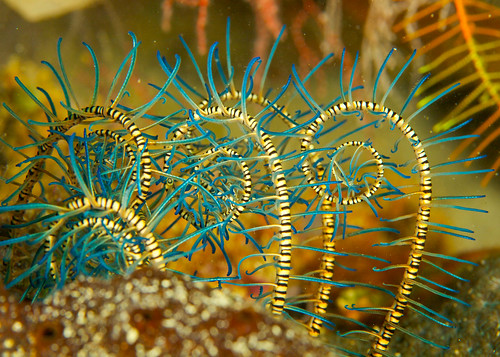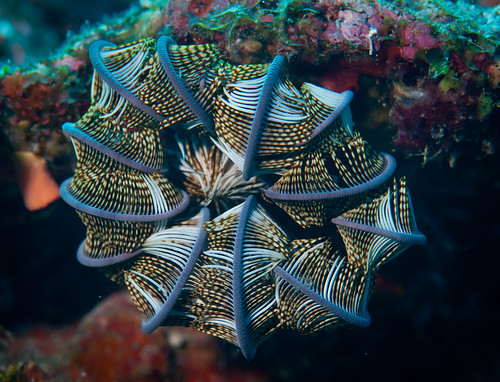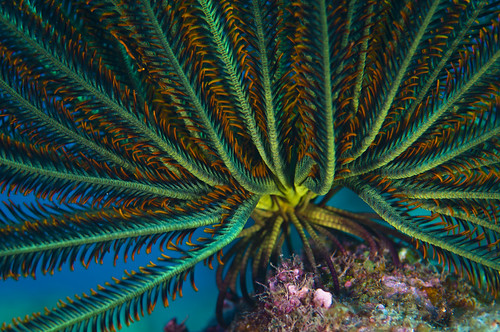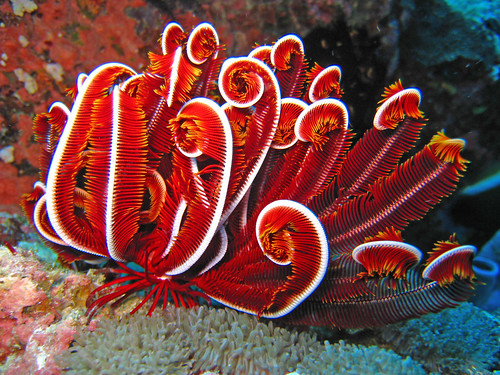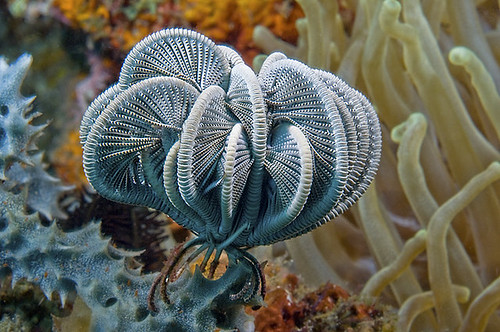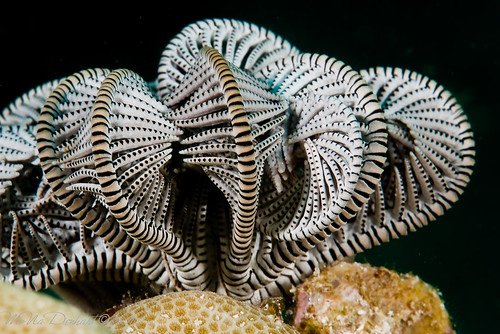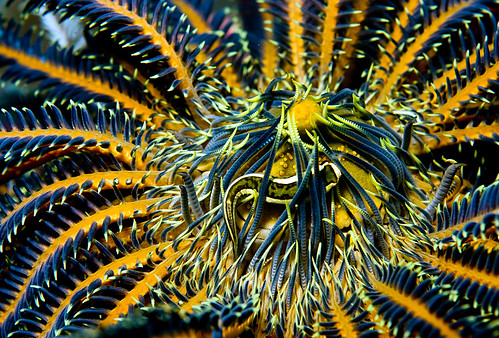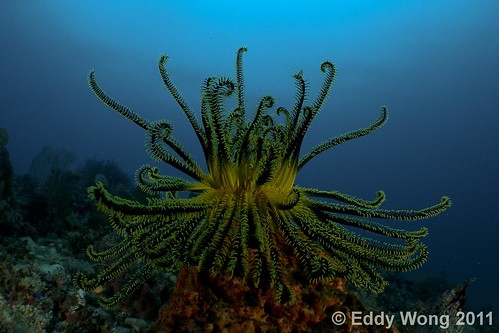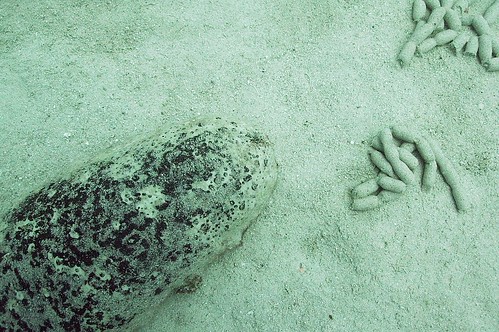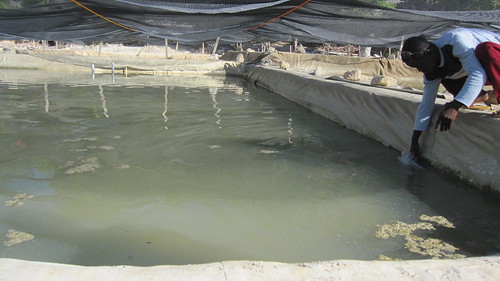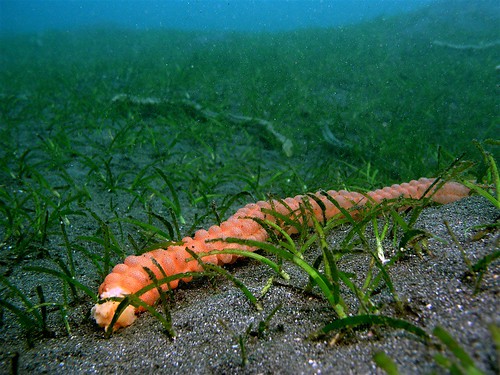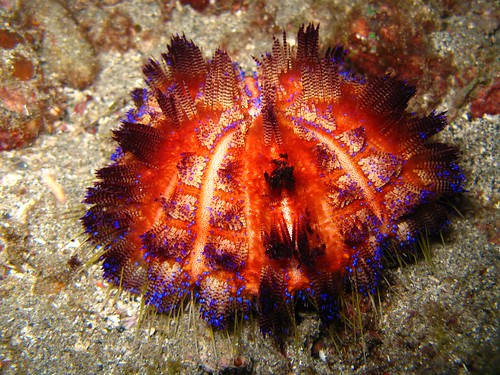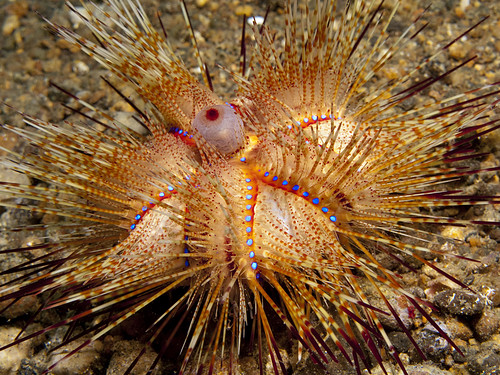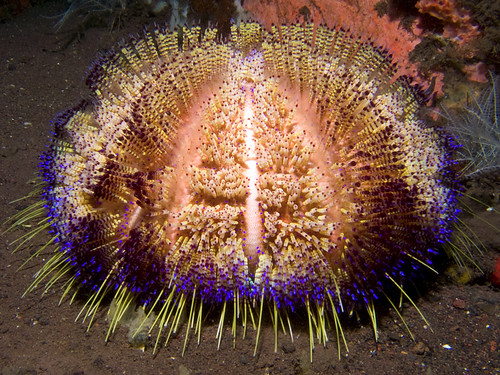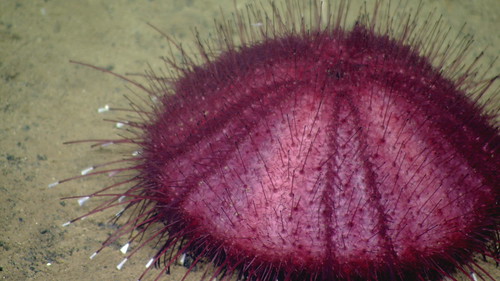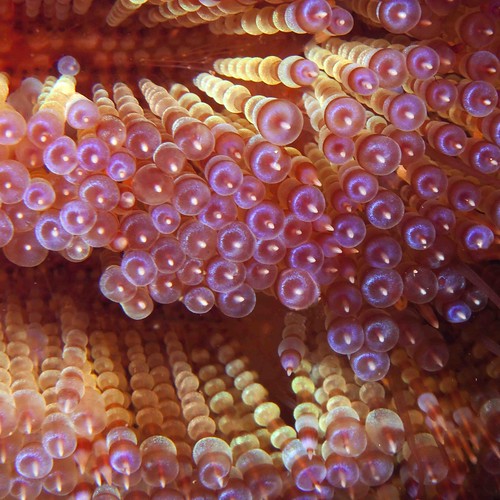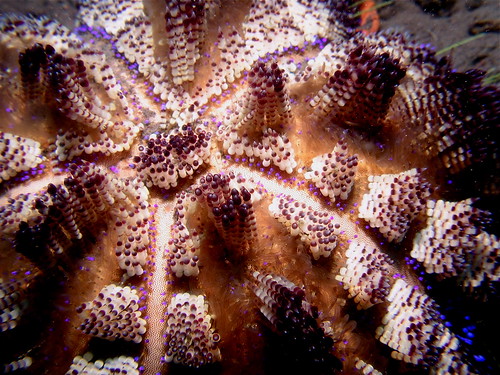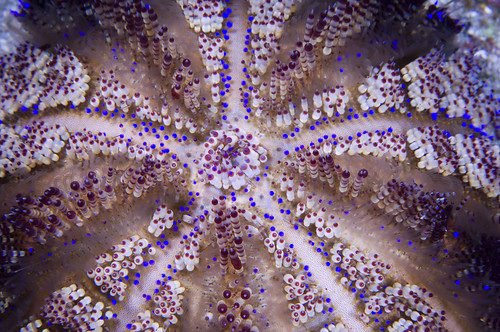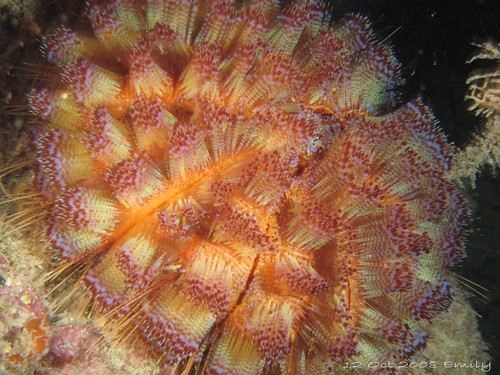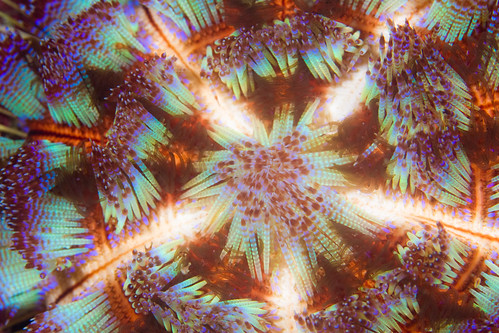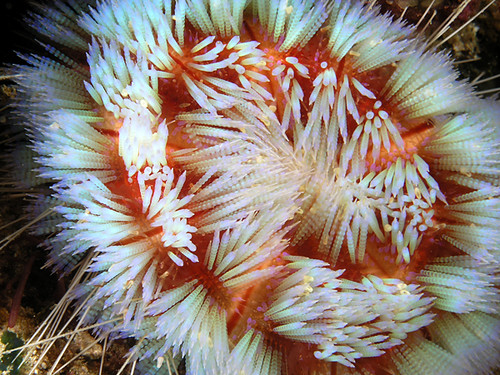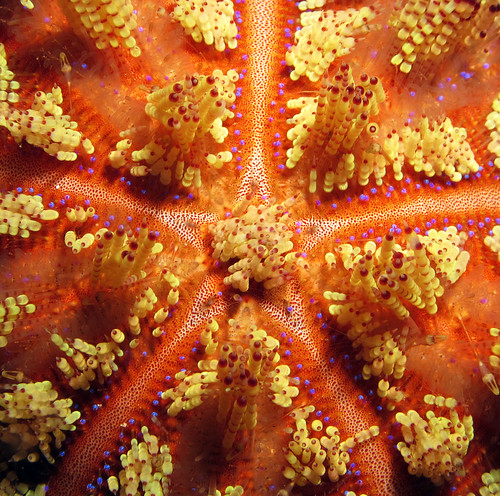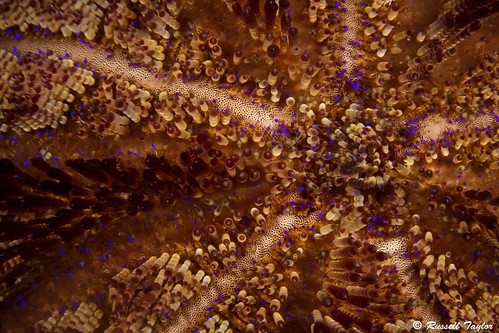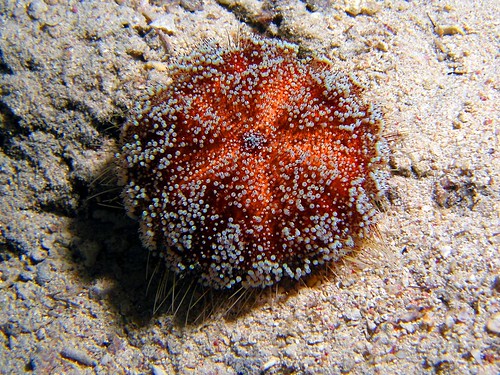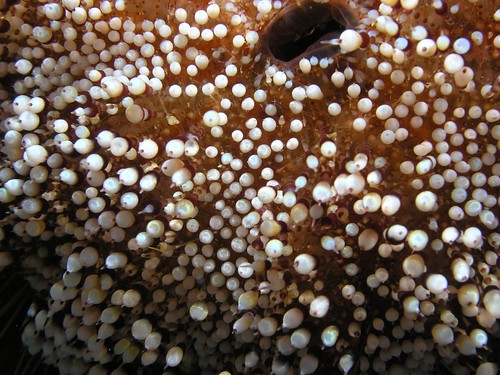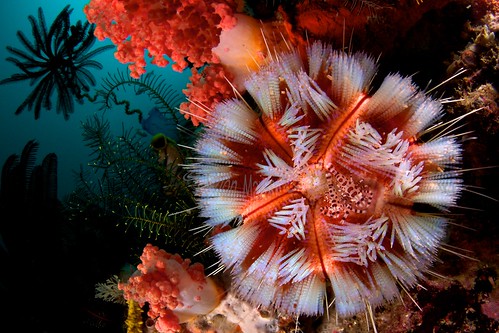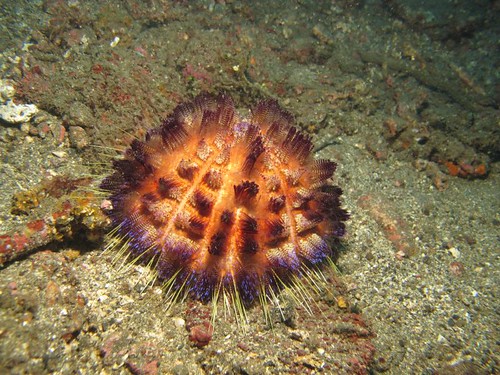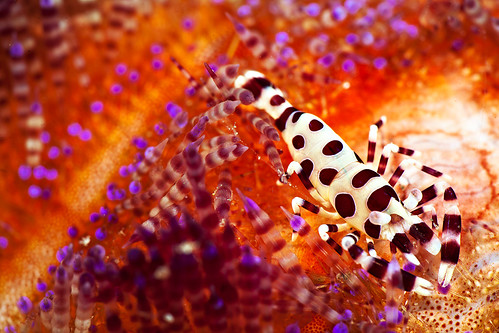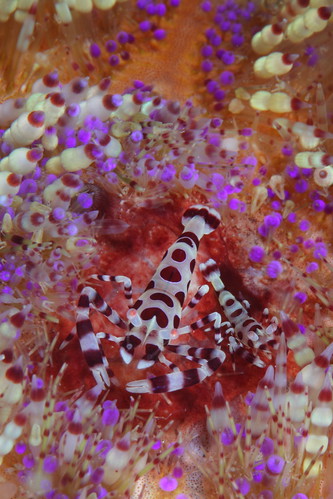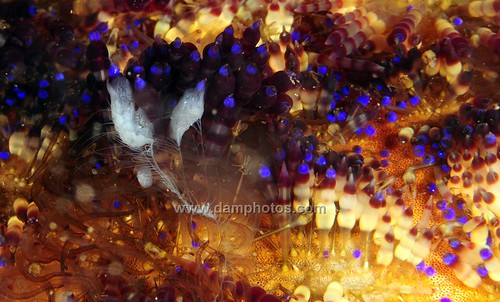 |
| Seriously! This is one of the top images that comes up in a Google search for "brooding" |
I meant Brooding juveniles like THIS!
Now, most starfish have a fairly straightforward reproductive cycle.
Eggs and sperm are ejected from the males and females-they fertilize and go on to form larvae which swim in the water developing through different stages, eventually eventually settling down onto the bottoms and growing up to become proper "adult" starfish.
But many starfish species stray from that typical cycle, and somewhere between the time the sperm fertilize the eggs and the settled "babies" are established the whole life cycle CHANGES to give you this:
Yes. Tiny baby or small juvenile starfish which are held by the mother around the mouth! (this varies as we'll see). Why do some starfish do this? And not the more 'typical' behavior?
They studied the large, Arctic/subArctic 6-rayed starfish Leptasterias polaris which occurs in the North Atlantic, Arctic and North Pacific Oceans.
Hamel and Mercier's paper exhaustively studies L. polaris' complete reproductive cycle, which pretty thoroughly documents the reproductive behavior in this species. Bear in mind, that this starfish has been known since 1842 and yet our knowledge of its reproduction has only come to us recently (published in 1995)!
Information on brooding remains of interest-but the behavior and its evolution is poorly understood.
As a prelude to the actual spawning there are massive aggregations of these animals. They're involved in an unusual behavior known as pseudocopulation. There's no penetration or combination of sexual organs, nor is there any actual spawning. The animals all just get together into a big pile. Sort of preparation for the main event.
Bear in mind, OTHER than during mating season (November to February), these animals all typically ignore or even avoid one another.
Many echinoderm species practice pseudocopulation which I've written about here. Its not always clear why different species pseudocopulate. But one thing seems clear: It helps the chances of their sperm and eggs get together.
2. Spawning! There were no pics of actual Leptasterias spawning, so here instead is a closely related Asterias. I have discussed this spawning on armtips position here. It is observed widely across cold water and tropical species.
The whole cycle is sumarized in this convenient cartoon!
And in the deep-sea, there is the weird "sea daisy" Xyloplax!
And that's not to mention brooding in sea urchins, ophiuroids, crinoids and sea cucumbers! and MANY other invertebrates! Starfish brooding is just the tip of the iceberg!
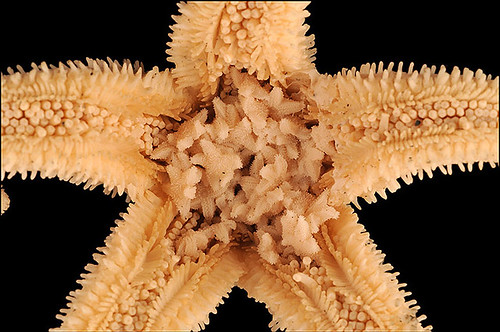 |
| from the Smithsonian NMNH USARP |
In other words, these are "baby" starfish that are cared for by the mother until they are ready to head off ont their own. Parental investment resulting in a succesful offspring.
Sometimes starfish (and indeed most echinoderms) can appear kind of alien. No head. Mouth on the bottom. 5 part radial symmetry. Strange adaptations. All kind of weird sometimes.
So, I suppose its appropriate that the WEIRDEST of ALL echinoderm (and starfish) behavior is that starfish have this almost mammal-like (or at least, vertebrate like) behavior!! Some starfish species will actually brood and carry little starfish just like the cutest little furry thing you can think of!
Eggs and sperm are ejected from the males and females-they fertilize and go on to form larvae which swim in the water developing through different stages, eventually eventually settling down onto the bottoms and growing up to become proper "adult" starfish.
But many starfish species stray from that typical cycle, and somewhere between the time the sperm fertilize the eggs and the settled "babies" are established the whole life cycle CHANGES to give you this:
Yes. Tiny baby or small juvenile starfish which are held by the mother around the mouth! (this varies as we'll see). Why do some starfish do this? And not the more 'typical' behavior?
Scientists have known about brooding behavior in several species of starfish since the 19th Century but only recently has there been the extensive observation and insight to finally piece together the complete story!
The Story of Leptasterias polaris
Information herein is based on a paper by Jean-Francois Hamel and Annie Mercier at Memorial University in Newfoundland. which you can find (here) in Biological Bulletin from 1995 (vol. 188: 32-45)
The Story of Leptasterias polaris
Information herein is based on a paper by Jean-Francois Hamel and Annie Mercier at Memorial University in Newfoundland. which you can find (here) in Biological Bulletin from 1995 (vol. 188: 32-45)
They studied the large, Arctic/subArctic 6-rayed starfish Leptasterias polaris which occurs in the North Atlantic, Arctic and North Pacific Oceans.
 |
| Image by Claude Nozeres from the Canadian Registry of Marine Species |
Information on brooding remains of interest-but the behavior and its evolution is poorly understood.
1. PSEUDOCOPULATION
 |
| Figure 1 from Hamel & Mercier 1995 |
Bear in mind, OTHER than during mating season (November to February), these animals all typically ignore or even avoid one another.
Many echinoderm species practice pseudocopulation which I've written about here. Its not always clear why different species pseudocopulate. But one thing seems clear: It helps the chances of their sperm and eggs get together.
2. Spawning! There were no pics of actual Leptasterias spawning, so here instead is a closely related Asterias. I have discussed this spawning on armtips position here. It is observed widely across cold water and tropical species.
Spawning in Leptasterias polaris males begins as the water gets cold, about 2 degrees C.
Sperm (male cells) are negatively buoyant, or in other words, they sink to the bottom and form sort of a film. The sperm then go dormant until they come into contact with the female's eggs..
3. The Female Pinwheel formation. Stimulated by the males, and following the deposition of sperm on the bottoms, the females proceed to eject the eggs onto the sperm so that fertilization can proceed.
The deposition of the eggs onto the sperm re-activates the sperm allowing them to combine and fertilize.
During this phase, the females adopt this "pinwheel" formation
 |
| From Mercier's L. polaris site |
Here (from Figure 5 in Mercier & Hamel) we see a close up of eggs UNDER the female in C. Which then grow up into the cute as the dickens starfish in D. Growth was after about 5 and half months.
4. After fertilization, development proceeds. Here's a summary panel of the different stages. The top row is the developing embryo. It continues through different stages until it reaches "J."
At that point the animal is practically ready to move off on its own..
 |
| Figure 9 showing development from embryos to small starfish |
Interestingly, Hamel & Mercer found that the development proceeded on its own if the embryos were unbrooded. They suggest that brooding is behavior which protects the embryos/juvenile starfish from debris and other materials. Animals observed in the field were clear of excess materials.
Protection was also a likely consideration since unprotected embryos/juvenile starfish were rapidly devoured by sea urchins or other grazing animals if they were not protected by the adult.
 |
| Figure 4 from Hamel & Mercier 1995 |
There were MANY more details! If the topic of brooding interests you I urge you to check it out!
BUT That's NOT the end of it!
5. Brooding is diverse. SEVERAL different species of sea stars brood. Almost all of them are either cold-water species, living in the deep-sea or at the poles. Sometimes brooding is in temperate water species.. But typically not in the tropics.
Brooding also takes different forms. The oral 'mouth' or gastric brooding mode is but one kind. Here is Diplasterias from the Antarctic! MANY starfish in the Antarctic brood juvenile starfish!
 |
| from the Smithsonian NMNH USARP |
For example, in the suspension feeding brisingids, the Antarctic species Odinella nutrix, broods babies in special chambers made from the arm spines present between each of the arms.
There is the strange Japanese/Russian/North Paciic Trophodiscus (go here to see more) Juveniles are brooding on the TOP of the animal among the spines (called paxillae) that compose the surface of the disk.
Here is a living specimen. Image by colleague Yoichi Kogure!
Close up
And then there's Tosia neossia, recently discovered in Australia. This species broods but without actually keeping the babies physically on the body. They are kept spread out near the animal... See the orange dots in the picture below? That's the juveniles... I wrote about this species here.
Here's the tiny Tosia crawling larvae!And in the deep-sea, there is the weird "sea daisy" Xyloplax!
And that's not to mention brooding in sea urchins, ophiuroids, crinoids and sea cucumbers! and MANY other invertebrates! Starfish brooding is just the tip of the iceberg!












